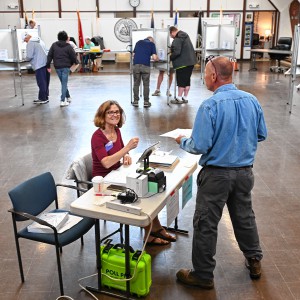Healey pitches ‘green bank’ for housing retrofits, new construction
| Published: 06-16-2023 3:41 PM |
BOSTON — With an eye on the state’s mid-century greenhouse gas emission reduction commitments, Gov. Maura Healey has announced the launch of a “green bank” that she hopes will attract private investment and federal money to pay for building retrofits and new construction of decarbonized buildings.
The Massachusetts Community Climate Bank will get started with $50 million from the Department of Environmental Protection and will be run out of MassHousing, making Massachusetts the first state to establish a green bank within its housing finance agency and to make affordable housing the focus of its strategy, the governor announced earlier this week.
The Healey administration said it expects to provide low-cost capital and “innovative deal structures” to promote the integration of clean energy and efficient technology into affordable housing development, and mortgage products for home improvements.
The program aims to pick up the pace on building decarbonization projects by lending directly to building owners and by “attracting and de-risking” loans or investments from private lenders.
The program looks to take advantage of affordable housing refinance cycles to help pay for heat pumps, building envelope efficiency upgrades, heat pump water heaters, high-efficiency appliances and solar panels as part of affordable housing renovations.
“The Massachusetts Community Climate Bank will be our financial engine for moving forward on our climate goals, relieving the pressure of high housing costs, and creating good jobs and healthier communities,” Healey said. “This first-of-its kind initiative is going to make our state more competitive, affordable and equitable — and it’s going to show that in Massachusetts, we can lead the world by leading with our values and leaving no community behind.”
In addition to a minimum 50% reduction in emissions by 2030, Massachusetts is required to reduce emissions by at least 75% by 2040 and at least 85% by 2050, all compared to the baseline of 1990 emissions levels. Policies like carbon sequestration are expected to help the state get the rest of the way to net-zero emissions by 2050.
The building sector is responsible for more than 25% of greenhouse gas emissions in Massachusetts, and can be responsible for as much as 70% of total greenhouse gas emissions in the state’s cities. The state’s Clean Energy and Climate Plan calls for a 49% reduction in greenhouse gas emissions from residential heating by 2030 and a 95% reduction by 2050.
Article continues after...
Yesterday's Most Read Articles
Because buildings last for decades, the state is emphasizing retrofits (as opposed to building new efficient structures) as part of its decarbonization strategy. Officials previously estimated that more than 80% of the buildings that will exist here in 2050 are already built.
“To achieve net-zero emissions by 2050, we in the commonwealth need to get to work renovating and electrifying our dated housing stock as soon as possible,” said Sen. Marc Pacheco. “This initial investment is a critical step for a just transition to a sustainable future and I look forward to supporting bold action amplifying these efforts.”
The Healey administration said the green bank will focus first on the affordable housing market since low- to moderate-income residents generally pay a disproportionate share of their income toward energy costs, have less control over their residences and have fewer resources to invest in clean energy technology. Over time, officials said, the bank will diversify its investments to include “other decarbonization measures that benefit communities.”
The governor’s office said the new green bank will also be positioned to compete for federal funding from the National Clean Investment Fund through the Inflation Reduction Act, and possibly to connect to other federal finance opportunities, like those at the U.S. Department of Energy Loan Program Office. Last week, the National Oceanic and Atmospheric Administration unveiled a $2.6 billion framework that the agency said is designed “to build climate resilience and support coastal communities” with Inflation Reduction Act funds. Details on how states could seek some of that money are expected to be available by early summer.
Tuesday’s announcement makes good on a pledge the governor made on her first day in office. In her inaugural speech in January, Healey said she would create a green bank “to foster investment in resilient infrastructure and attract new businesses.”
As a candidate for governor, Healey said she would not commit to pursuing a carbon tax, telling a WBUR and Environmental League of Massachusetts forum that she favors multi-state programs like the Regional Greenhouse Gas Initiative and the Transportation Climate Initiative, a similar market-based compact aimed at reducing transportation emissions that never materialized and collapsed in the face of opponents who highlighted the gas price increases that it would spur.
“I know things fell apart, OK,” Healey said in May 2022, referring to the Transportation Climate Initiative. “But we’re in a different place than we were a year, or two, or three ago. And we have an opportunity to revisit that, and I promise as governor I will bring the urgency to that and the commitment to trying to drive regional solutions to our climate needs.”

 Political newcomer defeats Shores Ness for Deerfield Selectboard seat
Political newcomer defeats Shores Ness for Deerfield Selectboard seat New Salem election ushers in new Selectboard member
New Salem election ushers in new Selectboard member Bridge of Flowers in Shelburne Falls to open on plant sale day, May 11
Bridge of Flowers in Shelburne Falls to open on plant sale day, May 11 Community Legal Aid expands Disability Benefits Project to Franklin County
Community Legal Aid expands Disability Benefits Project to Franklin County
